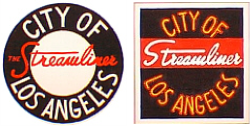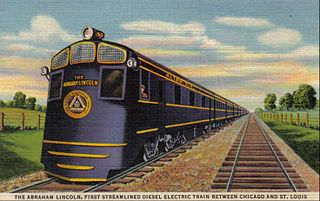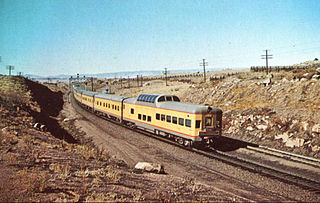
The Broadway Limited was a passenger train operated by the Pennsylvania Railroad (PRR) between New York City and Chicago. It operated from 1912 to 1995. It was the Pennsylvania's premier train, competing directly with the New York Central Railroad's 20th Century Limited. The Broadway Limited continued operating after the formation of Penn Central (PC) in February 1968, one of the few long-distance trains to do so. PC conveyed the train to Amtrak in 1971, who operated it until 1995. The train's name referred not to Broadway in Manhattan, but rather to the "broad way" of PRR's four-track right-of-way along the majority of its route.

The Super Chief was one of the named passenger trains and the flagship of the Atchison, Topeka and Santa Fe Railway. The then-modern streamliner was touted in its heyday as "The Train of the Stars" because it often carried celebrities between Chicago, Illinois, and Los Angeles, California.

The City of Denver was a streamlined passenger train operated by the Union Pacific Railroad between Chicago, Illinois, and Denver, Colorado. It operated between 1936 and 1971. From 1936–1955 the Chicago and North Western Railway handled the train east of Omaha, Nebraska; the Chicago, Milwaukee, St. Paul and Pacific Railroad handled it thereafter. The train was the fastest long-distance train in the United States when it debuted in 1936, covering 1,048 miles (1,687 km) in 16 hours. For almost its entire career its principal competitor was the Chicago, Burlington and Quincy Railroad's Denver Zephyr. When Amtrak assumed operation of most intercity trains in the United States in 1971, it discontinued the City of Denver, preferring to use the Burlington's route between Chicago and Denver.

The City of Los Angeles was a streamlined passenger train between Chicago, Illinois, and Los Angeles, California via Omaha, Nebraska, and Ogden, Utah. Between Omaha and Los Angeles it ran on the Union Pacific Railroad; east of Omaha it ran on the Chicago and North Western Railway until October 1955 and on the Milwaukee Road thereafter. The train had number 103 westbound and number 104 eastbound.

The El Capitan was a streamlined passenger train operated by the Atchison, Topeka and Santa Fe Railway between Chicago, Illinois, and Los Angeles, California. It operated from 1938 to 1971; Amtrak retained the name until 1973. The El Capitan was the only all-coach or "chair car" to operate on the Santa Fe main line between Chicago and Los Angeles on the same fast schedule as the railroad's premier all-Pullman Super Chief. It was also the first train to receive the pioneering Hi-Level equipment with which it would become synonymous.

The Coast Daylight, originally known as the Daylight Limited, was a passenger train on the Southern Pacific Railroad (SP) between Los Angeles and San Francisco, California, via SP's Coast Line. It was advertised as the "most beautiful passenger train in the world," carrying a particular red, orange, and black color scheme. The train operated from 1937 until 1974, being retained by Amtrak in 1971. Amtrak merged it with the Coast Starlight in 1974.

The Aerotrain was a streamlined trainset that the General Motors (GM) Electro-Motive Division (EMD) introduced in 1955. GM originally designated the light-weight consist as Train-Y before the company adopted the Aerotrain marketing name.

The City of San Francisco was a streamlined through passenger train which ran from 1936 to 1971 on the Overland Route between Chicago, Illinois and Oakland, California, with a ferry connection on to San Francisco. It was owned and operated jointly by the Chicago and North Western Railway (1936–55), Chicago, Milwaukee, St. Paul and Pacific Railroad (1955–71), the Union Pacific Railroad, and the Southern Pacific Railroad. It provided premium extra fare service from Chicago to San Francisco when introduced in 1936 with a running time of 39 hours and 45 minutes each way.

The Columbian was a named passenger train operated by the Baltimore and Ohio Railroad. It was the all-coach supplemental train of the all-Pullman Capitol Limited. It operated from 1931 to 1964. The train's initial route was between Jersey City, New Jersey and Washington, D.C., but in 1941 the Columbian route was lengthened to Jersey City – Chicago, Illinois. It was the first air-conditioned train in the United States.

The National Limited was the premier train of the Baltimore and Ohio Railroad (B&O) on its route between Jersey City, New Jersey and St. Louis, Missouri, with major station stops in Washington, D.C., and Cincinnati, Ohio. It operated from 1925 to 1971. For much of its life it offered exclusive all-Pullman service, and it was the first long-distance train to be entirely air-conditioned. The National Limited was one of many trains discontinued when Amtrak began operations on May 1, 1971. Amtrak revived the name for another New York–St. Louis service which did not use the B&O route.

The Rocky Mountain Rocket was a streamlined passenger train of the Chicago, Rock Island and Pacific Railroad. Rock Island's train numbers 7 and 8 ran between Chicago's LaSalle Street Station and Denver's Union Station and Colorado Springs, Colorado. The Rocky Mountain Rocket ran from 1939 to 1966; the train was discontinued prior to the creation of Amtrak in 1971.

The Southerner was a streamlined passenger train operated by the Southern Railway in the United States between New York City and New Orleans via Charlotte, Atlanta and Birmingham. It operated from 1941 to 1970.

The Abraham Lincoln was a named passenger train operated by the Baltimore and Ohio Railroad from 1935 into the 1960s. The Abe Lincoln ran between Chicago and St. Louis on the B&O's subsidiary Alton Railroad. The train later passed to the Gulf, Mobile and Ohio Railroad, and then finally to Amtrak, which retained the name until 1978. Service between Chicago and St. Louis is now known by the umbrella term Lincoln Service. This train was the first streamlined passenger service to travel the 284 miles between Chicago and St. Louis, with Joliet, Bloomington-Normal, Springfield and Alton in between. Passengers can get a glimpse of the Mississippi River between Alton and St. Louis.

The Winnipeg Limited was an overnight named passenger train operated by the Great Northern Railway 457 miles (735 km) between St. Paul-Minneapolis and Winnipeg, Manitoba. It competed on the route with the overnight Winnipeger of the Minneapolis, St. Paul and Sault Ste. Marie Railway, and the Northern Pacific Railway's unnamed daytime passenger train. The service was truncated to run between Manitoba and Grand Forks after February 2, 1970.

The City of Memphis was a 236.8-mile (381.1 km) passenger train route operated by the Nashville, Chattanooga and St. Louis Railway connecting Nashville's Nashville Union Station and Memphis, Tennessee's Memphis Union Station.

The Los Angeles Limited was a named passenger train in the United States. It was operated by the Union Pacific Railroad from 1905 to 1954.

The Chicago, Rock Island and Pacific Railroad Rockets were lightweight, streamlined diesel-electric passenger trains built by the Budd Company. These six trains were the first streamlined equipment purchased by the Rock Island, as well as being its first diesel-powered passenger trains. Four of the trains consisted of three cars each, the other two each had four cars.

The Green Diamond was a streamlined passenger train operated by the Illinois Central Railroad between Chicago, Illinois and St. Louis, Missouri. It operated from 1936 until 1968. It was the Illinois Central's first streamliner. Initially it operated with Illinois Central 121, the last of the 1930s fixed-consist articulated streamliners built in the United States.

The Blue Bird was a streamlined passenger train operated by the Wabash Railroad and its successor the Norfolk and Western Railway between Chicago, Illinois, and St. Louis, Missouri. It operated from 1938 to 1971. Beginning in 1950 it was one of the few Wabash passenger trains to carry a dome car and the first dome train in regular operation between the two cities. The train was cut back to Decatur, Illinois, in 1968 and renamed City of Decatur. Amtrak did not retain the City of Decatur, and it made its last run on April 30, 1971.

The Astra Domes were a fleet of streamlined dome cars built by the American Car and Foundry Company ("ACF") and later by Pullman-Standard ("PS") for the Union Pacific Railroad between 1954–1958. ACF built a total of 35 cars including coaches, dining cars, and observation cars, while PS built 5 for Union Pacific. After Union Pacific exited the passenger business in 1971 the Auto-Train Corporation purchased most of the fleet and operated them for an additional ten years.



















